The Stewardship Mapping Project
What We Learned
The STEW-MAP survey asks stewardship groups when they were founded, how many paid staff people they have, what kinds of sites they work on, who they work with, what they do besides environmental stewardship, and lots more.
The answers to a variety of questions are below. Please keep in mind that many people skipped one or more questions so we always report how many people actually answered each question. Most people filled out the survey in 2011 or 2012 when STEW-MAP was launched in the Chicago region.
If you’re specifically interested in the social network data, click here
- What kinds of groups and organizations participated in the STEW-MAP survey?
406 groups answered the question “What is your group/organization's legal designation?”
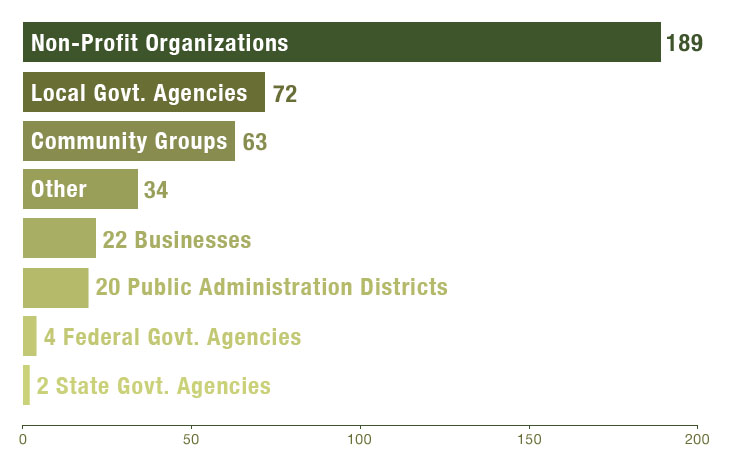
- When was your group founded?
For the 340 groups that answered this question, the years ranged from 1834 (wow! In fact 19 groups were founded before 1900!) to 2013. About half of the groups were less than 20 years old. Note that most people filled out the survey in 2011 so only a few groups said they were founded after 2011.
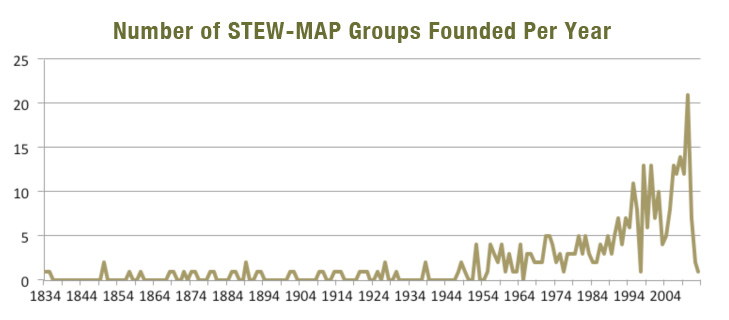
- What types of stewardship do they do?
STEW-MAP defines stewardship as ‘environmental restoration, monitoring, education, conservation/preservation, advocacy, and/or taking care of a particular place or patch of land.’ Of the 416 groups that answered this question, the number one response was environmental education (372 groups picked this), but not by much. Note that each group could pick more than one answer for this question.
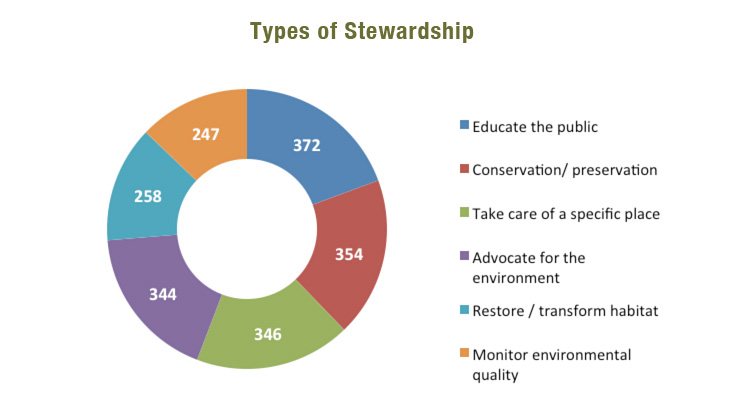
- Where are the stewardship groups headquartered?
We say ‘headquartered’ because a stewardship group may have an office in one location, but work at multiple sites, or have an outreach ‘territory’ covering a county or the whole state. ‘Where a group or organization actually does stewardship work’ is a separate question – see the online map to learn more about that.
The vast majority of groups (94%) were located in Illinois – this makes sense because most of Chicago Wilderness’s territory is in Illinois and we also did most of our outreach for the survey in Illinois. Just over half of the groups were from Chicago.
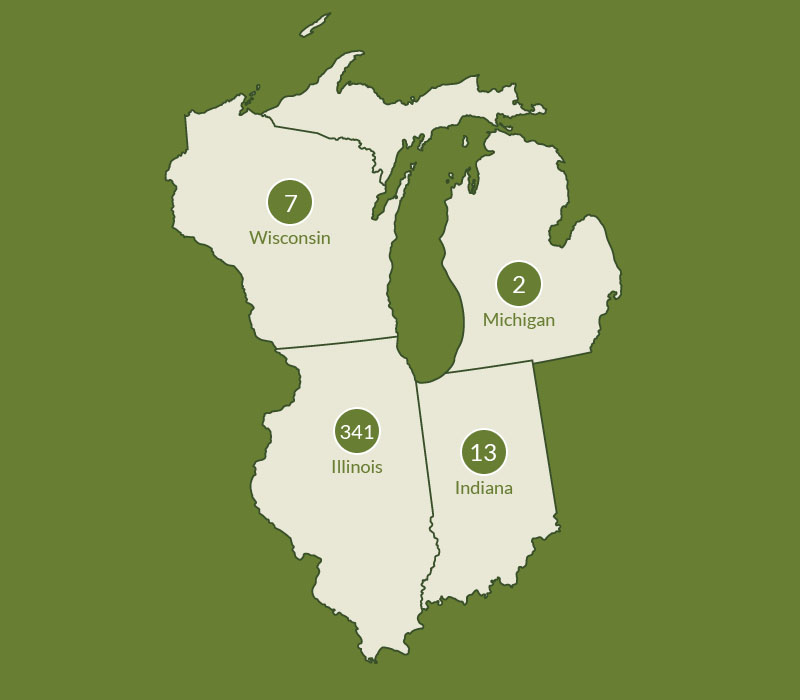
Breakdown by county
Note that we counted ‘City of Chicago’ as separate from ‘Suburban Cook County.’
- County
- Champaign
- City of Chicago
- Cook (Suburban)
- DuPage
- Iroquois
- Kane
- Kendall
- Lake
- Lee
- McHenry
- Oak
- Ogle
- Sangamon
- Will
- Winnebago
- Lake
- LaPorte
- Porter
- Tippecanoe
- Berrien
- Washtenaw
- Kenosha
- Outagamie
- Racine
- Walworth
- State
- IL
- IL
- IL
- IL
- IL
- IL
- IL
- IL
- IL
- IL
- IL
- IL
- IL
- IL
- IL
- IN
- IN
- IN
- IN
- MI
- MI
- WI
- WI
- WI
- WI
- Number of Groups
- 1
- 191
- 65
- 14
- 1
- 18
- 4
- 21
- 1
- 6
- 1
- 3
- 1
- 12
- 1
- 4
- 3
- 5
- 1
- 1
- 1
- 1
- 1
- 1
- 3
Breakdown by City
OK, you asked for it. Here are the cities and towns that had two or more stewardship groups. There were no Michigan or Wisconsin cities with two or more groups.
Illinois
- City
- Barrington
- Batavia
- Blue Island
- Buffalo Grove
- Chicago
- Elgin
- Evanston
- Frankfort
- Franklin Park
- Geneva
- Glenview
- Grayslake
- Gurnee
- Joliet
- Long Grove
- Matteson
- Naperville
- Oak Park
- Oregon
- Park Ridge
- Riverside
- Schaumburg
- Skokie
- Waukegan
- Westchester
- Wheaton
- Wilmette
- Woodstock
- Yorkville
- Number of Groups
- 4
- 3
- 3
- 2
- 191
- 6
- 11
- 4
- 2
- 2
- 5
- 2
- 2
- 3
- 2
- 2
- 2
- 7
- 3
- 2
- 3
- 4
- 2
- 2
- 2
- 3
- 2
- 3
- 3
Indiana
- City
- Hammond
- Michigan City
- Portage
- Number of Groups
- 2
- 2
- 2
- What do groups work on?
We provided a long list of issues and topics and asked each group to pick which ones they worked on. In the first question, they could pick as many from the list as they wanted. For the 384 groups that answered this question, ‘Environment’ came out on top of the list (of course! this was an environmental stewardship survey after all), but they worked on lots of other things as well. Education was the second most common activity followed by community development/capacity building, youth development, recreation/sports and so on. You can see for yourself in the word cloud.
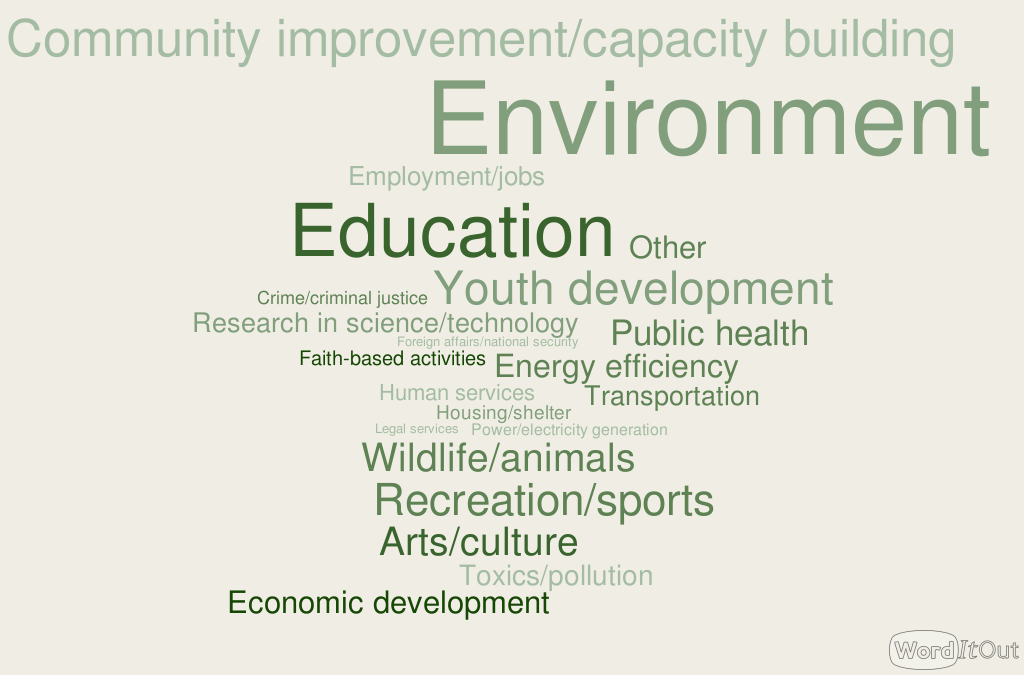
Here is a view of this information in a more traditional table:
- Issue or Topic
- Environment
- Education
- Community improvement/ capacity building
- Youth Development
- Recreation/sports
- Wildlife/animals
- Arts/culture
- Public Health
- Energy efficiency
- Economic development
- Other
- Toxics/pollution
- Research in science/technology
- Transportation
- Employment/jobs
- Human services
- Faith-based activities
- Housing/shelter
- Crime/criminal justice
- Power/electricity generation
- Foreign affairs/national security
- Legal services
- Number of Groups
- 339
- 232
- 152
- 132
- 125
- 105
- 103
- 89
- 81
- 74
- 74
- 62
- 60
- 58
- 54
- 41
- 31
- 26
- 21
- 19
- 10
- 8
- What is the group’s primary focus?
Then, using the same list of issues or topics, we asked them to tell us their primary focus. ‘Environment’ came out on top for just over half of the 404 groups that answered this question, followed by ‘Education’ and ‘Community development/capacity building.’ Here’s the word cloud.
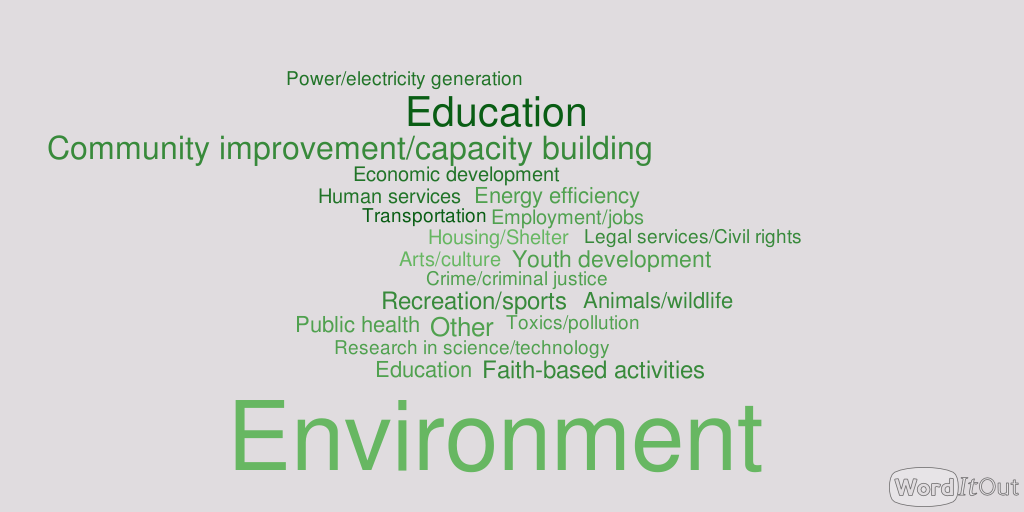
Here are the top 7 “Primary Focus” categories in a pie chart
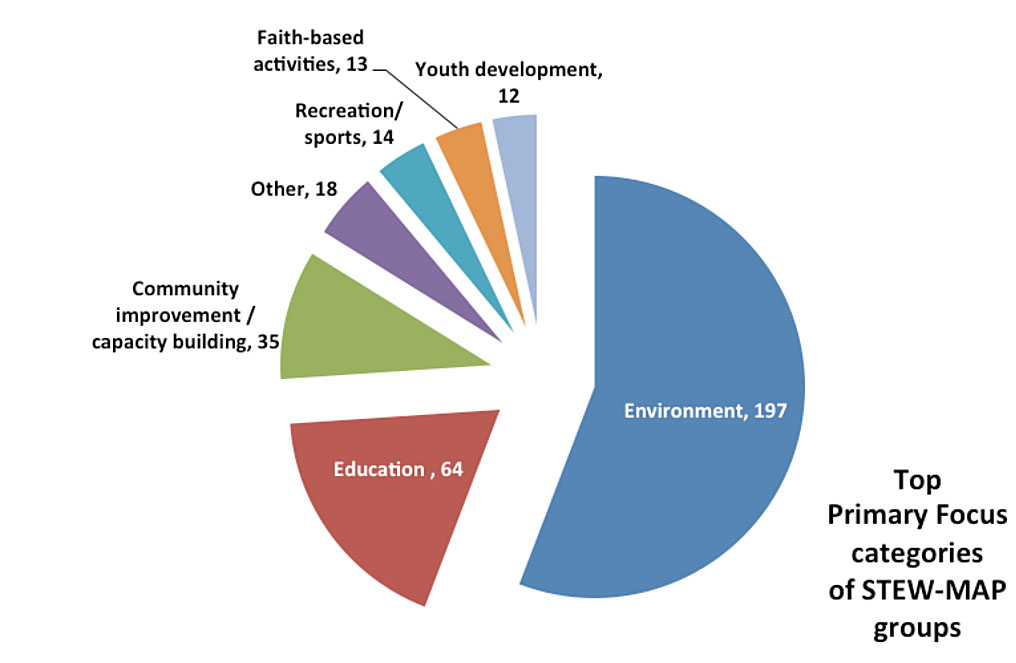
- What kinds of sites are people doing stewardship work on?
We asked what kinds of sites the groups did stewardship work on. For the 384 groups that answered this question, the top responses were Prairie (195), Forest/Woodland (177), Wetland (155) and Community Garden (153). But every kind of site that you can imagine is getting some attention from stewardship groups across the region.
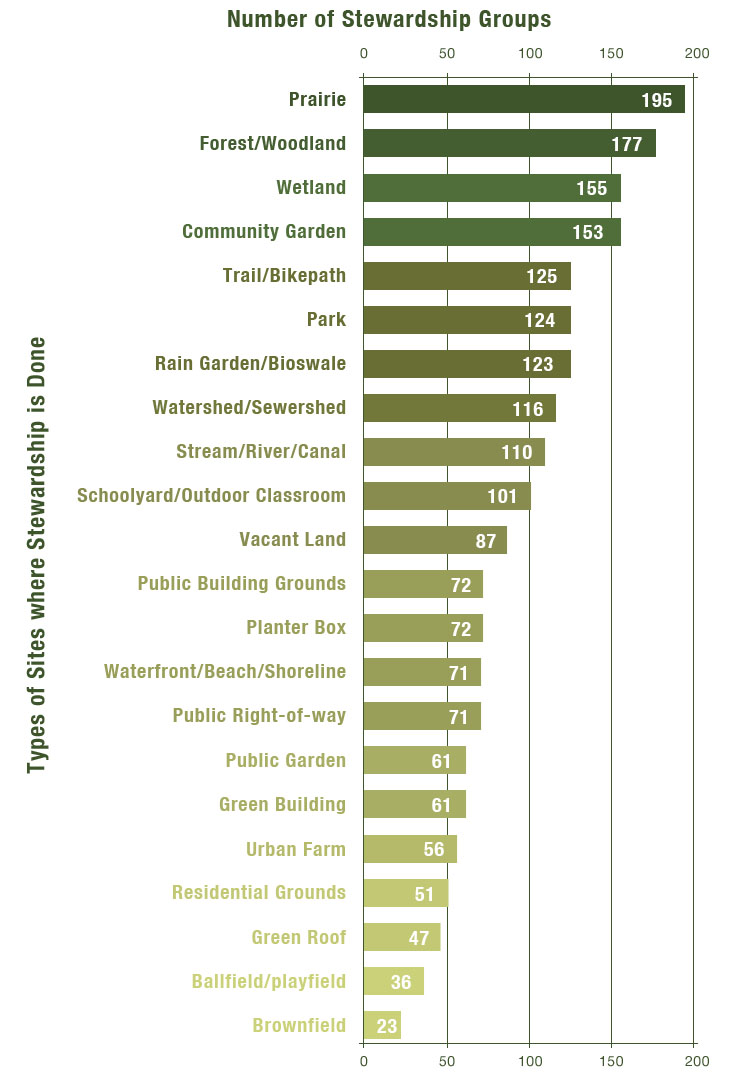
- Why do people do environmental stewardship work?
We asked people to tell us why their group or organization does stewardship work and 312 people answered. They mentioned a range of motivations related to improving their local community, taking responsibility to care for the environment, and fulfilling personal goals.
The responses to this question are hard to summarize and count so here is a sample of what people said and a word cloud that shows the words they used most frequently:
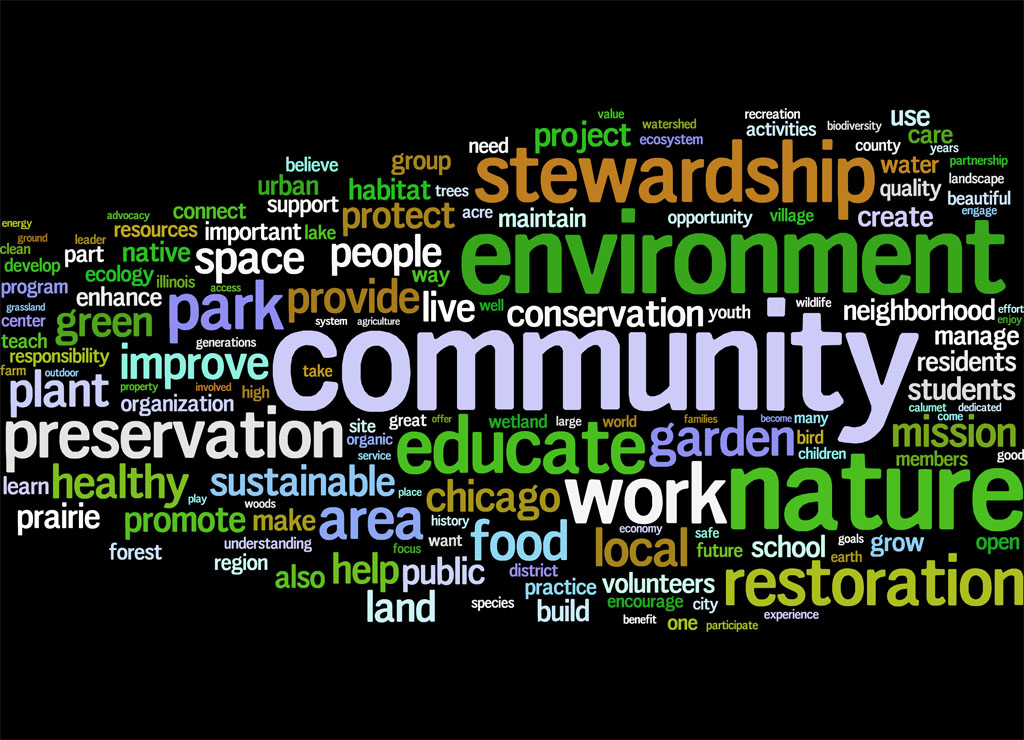
“Why? I'm just built this way. How can you walk past a neighbor in need and look away? I cannot. I must solve problems, I cannot ignore them.”
“Living in the city does not provide much opportunity for people to reconnect with the earth, and youth who have grown up in urban settings their entire lives need an opportunity to interact with the earth, learn about its relevance to their lives, and gain cultural insights from older generations.”
“We want to restore some semblance of the local natural beauty, peace and power that was destroyed during development. We want to create a place where people feel peaceful and happy.”
“We believe trees, flowers and clean open space are essential to the well-being of our community. There is a shortage of public green space in our densely-populated neighborhood and we wish to protect and improve our little park for all to enjoy.”
“Stewardship is critical for the long term success of our country. Our organizations bring history, farming and the environment together as they are inseparable and must be understood to maintain the heritage of freedom in our country, its blessings of natural resources and its agricultural bounty.”
“We do stewardship to create and promote green infrastructure. We try to work with nature in solving issues such as groundwater infiltration, stormwater management and cleaning, and erosion control.”
“We believe we are responsible for nurturing the earth and leaving it better than we found it.”
“Our primary purpose is to empower our students and families to care for their school and neighborhood environment through education and stewardship. Our neighborhood is fairly high crime, so student outdoor experiences are limited.”
“We believe that social justice, economic security, and community political participation is strengthened when community members are empowered and have access to land for the purpose of growing food.”
“Some of us get school credit for community service. We learn the names of plants that grow in the area and protect habitat so killdeer can raise families.”
“We are not primarily an environmental group, but we partner with others to improve nutrition by increasing access to fresh fruits and vegetables and to increase physical activity by making sure there are safe and inviting spaces to play and move.”
“Our group does stewardship work because the community needs people who care about the green areas within our city.”
“[At the beach where we work,] people who want a flat, bug-free, sun-filled beach have plenty of space and we have a habitat for flora and fauna. Even people who love to play volleyball at the beach understand how beautiful and appropriate our restoration project is.”
“The world that we received from past generations is not of the same quality as the world we are passing onto the next generation. We have lost the knowledge that how we are living on the land is negativity affecting the natural ecosystems of the planet.”
“Our engagement in this work help connect and/or reconnect children with nature and encourage attitude of caring plus good stewardship as they experience the awe and wonder of God's creation, natural communities in their local place.”

